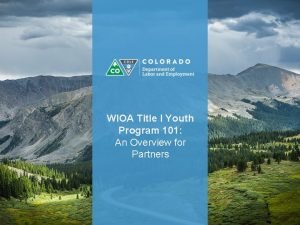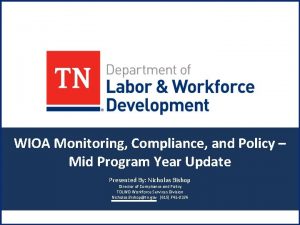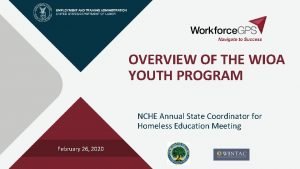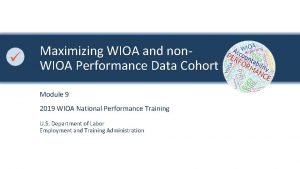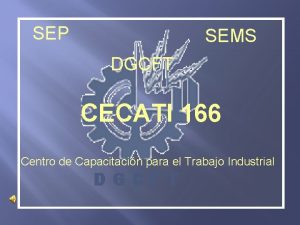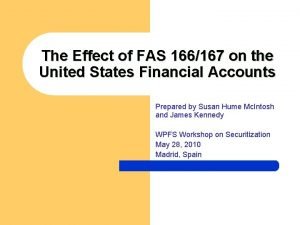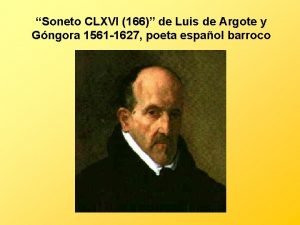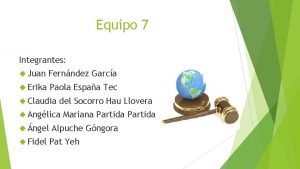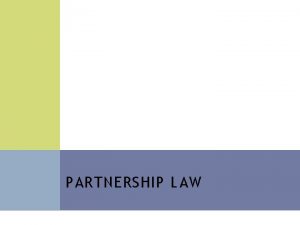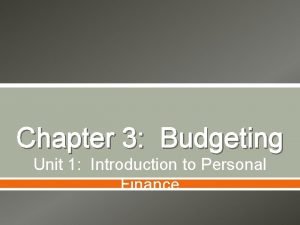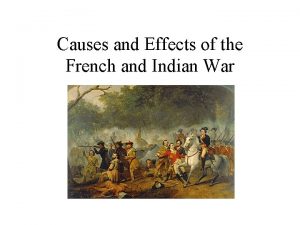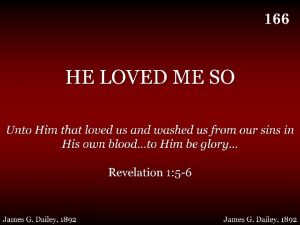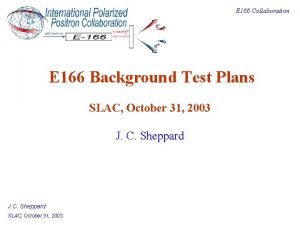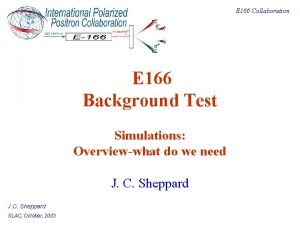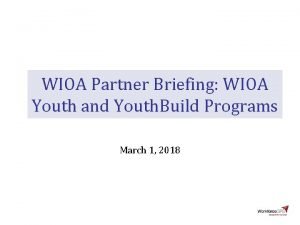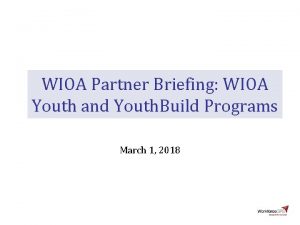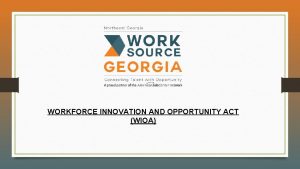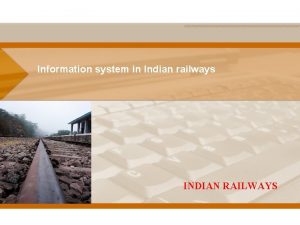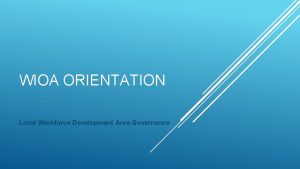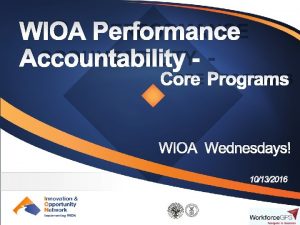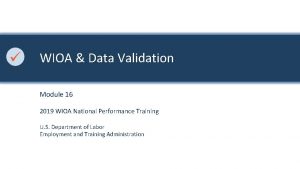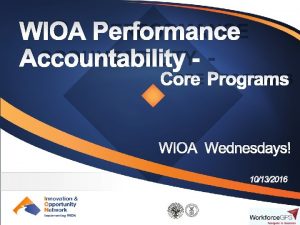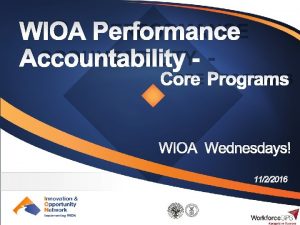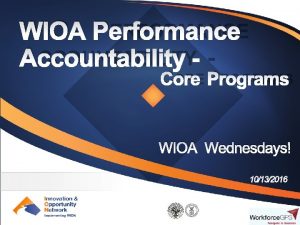WIOA 101 and WIOA Section 166 Indian and




















- Slides: 20

WIOA 101 and WIOA Section 166 – Indian and Native American Program U. S. Department of Labor Employment and Training Administration

Presenters Duane Hall Federal Project officer Division of Indian and Native American Programs Employment and Training Administration U. S. Department of Labor Have a question or comment about WIOA? E-mail DOL. WIOA@dol. gov 2

Our Agenda: Setting the Stage o Brief Orientation to the Law and What WIOA Means for the Overall Workforce System o Overview of WIOA Section 166 – the Indian and Native American Program o In-Depth Discussion on the Biggest Change - Performance

Orientation to WIOA ○ Signed into law July 22, 2014 however ETA didn’t begin operating under the new law until PY 2015 (July 1, 2015). ○ First major workforce development legislation since the Workforce Investment Act of 1998 ○ Title I replaced WIA employment and training services for adults, dislocated workers, and youth, as well as Indian and Native American Programs (Most provisions took effect July 1, 2015) ○ The Native American program is still at section 166 of WIOA ○ Title II amended Adult Education and Literacy programs ○ Title III amended Wagner-Peyser employment services connecting employers with qualified job seekers ○ Title IV amended Vocational Rehabilitation services helping individuals with disabilities work and be independent 4

Status of the Regulations 5 Notices of Proposed Rule Making (NPRMs) released April 16, 2015 1. DOL-ED Joint Rule for Unified and Combined State Plans, Performance Accountability, and the One-Stop System Joint Provisions 2. DOL guidance on DOL-only provisions of Title I adult, dislocated, and youth workforce services and Title III Wagner-Peyser 3. ED guidance on Title II Adult Education and Family Literacy 4. ED guidance on Title IV State Vocational Rehabilitation Services Program; State Supported Employment Services Program; Limitations on Use of Subminimum Wage 5. ED guidance on miscellaneous program changes Federal partners are in the process of finalizing regulations 5

WIOA Section 166 Support employment and training activities for Indian, Alaska Native, and Native Hawaiian individuals in order to: 1. Develop more fully the academic, occupational, and literacy skills of such individuals; 2. Make such individuals more competitive in the workforce and to equip them with entrepreneurial skills necessary for successful self-employment; and 3. Promote the economic and social development of Indian, Alaska Native, and Native Hawaiian communities in accordance with the goals and values of such communities. 6

WIOA Section 166 Changes ○ WIOA requires that grants be competed every 4 -years as opposed to every 2 -years under WIA ○ WIOA requires a 4 -year plan as opposed to a 2 -year plan under WIA ○ Emphasizes entrepreneurial skills by adding language to the purpose of the program to equip individuals with entrepreneurial skills ○ Maintains the Secretary’s Native American Advisory Council 7

WIOA Section 166 Changes Continued ○ WIOA changed youth eligible to 14 -24 years of age compared to 14 -21 under WIA. Youth must also be low-income to participate in the youth program and WIOA changed the definition of low-income to include any youth living in a “high poverty” area. ○ Ongoing participation in Section 477 – proposed rule reduces burden for plan review ○ Performance measures change 8

WIOA Section 166 Changes Continued ○ States’ Local Workforce Development Boards (LWDB) have been significantly reduced in size by eliminating the requirement that a representative from each of the one-stop partners must be included. This means that Native American grantees are no longer required members on the LWDB. ○ Native American grantees shall not be subject to the funding of the One-Stop Infrastructure unless otherwise agreed upon in the MOU under subpart C of 20 CFR part 678 (WIOA Section 121(h)(2)(D)(iv). 9

WIOA Section 166 Changes Continued ○ Provides authorization to the Secretary to award grants, to entities with demonstrated experience and expertise in developing and implementing programs for the unique populations who reside in Alaska or Hawaii to improve job training and workforce investment activities for such unique populations. ○ Section 166 (k) - Authorized Appropriations to carry out this subsection: (A) $461, 000 for fiscal year 2015; (B) $497, 000 for fiscal year 2016; 10

WIOA Section 166 Changes Continued (C) $507, 000 for fiscal year 2017; (D) $518, 000 for fiscal year 2018; (E) $530, 000 for fiscal year 2019; and (F) $542, 000 for fiscal year 2020. ○ Section 172(a) - There authorized to be appropriated to carry out section 166 – (1) $46, 082, 000 for fiscal year 2015; (2) $49, 641, 000 for fiscal year 2016; 11

WIOA Section 166 Changes Continued (3) $50, 671, 000 for fiscal year 2017; (4) $51, 795, 000 for fiscal year 2018; (5) $53, 013, 000 for fiscal year 2019; and (6) $54, 137, 000 for fiscal year 2020. 12

WIOA Section 166 Changes Continued ○ Section 166(e)(5) of WIOA states that grantees shall include the primary indicators of performance described in section 116(b)(2)(A). . . ” ○ Section 166(h) of WIOA states that in addition to the primary indicators of performance described in section 116(b)(2)(A), the Secretary, in consultation with the Native American Advisory Council shall develop a set of performance indicators and standards that shall be applicable to the Native American program. 13

WIOA Section 116(b)(2) Adult Performance Indicators (1) The percentage of program participants who are in unsubsidized employment during the second quarter after exit from the program; (2) The percentage of program participants who are in unsubsidized employment during the fourth quarter after exit from the program; (3) The median earnings of program participants who are in unsubsidized employment during the second quarter after exit from the program; 14

WIOA Section 116(b)(2) (4) The percentage of program participants who obtain a recognized postsecondary credential, or a secondary school diploma or its recognized equivalent (subject to WIOA sec. 116(b)(2)(A)(iii)) during participation in or within 1 year after exit from the program; (5) The percentage of program participants who, during a program year, are in an education or training program that leads to a recognized postsecondary credential or employment and who are achieving measurable skill gains toward such a credential or employment; 15

WIOA Section 116(b)(2) (6) The indicators of effectiveness in serving employers established under section 116(b)(2)(A)(iv); 16

WIOA Section 116(b)(2) Youth Performance Indicators (1) The median earnings of program participants who are in unsubsidized employment during the second quarter after exit from the program; (2) The percentage of program participants who obtain a recognized postsecondary credential, or a secondary school diploma or its recognized equivalent (subject to WIOA section 116(b)(2)(A)(iii)) during participation in or within 1 year after exit from the program; 17

WIOA Section 116(b)(2) (3) The percentage of program participants who, during a program year, are in an education or training program that leads to a recognized postsecondary credential or employment and who are achieving measurable skill gains toward such a credential or employment; (4) The indicators of effectiveness in serving employers established under section 116(b)(2)(A)(iv); 18

WIOA Section 116(b)(2) (5) The percentage of program participants who are in education or training activities, or in unsubsidized employment, during the second quarter after exit from the program; and (6) The percentage of program participants who are in education or training activities, or in unsubsidized employment, during the fourth quarter after exit from the program 19

High Poverty Proposed Definition in the NPRM ○ High-poverty area means a Census tract, a set of contiguous Census tracts, or a county or Indian reservation that has a poverty rate of at least 30 percent as set every 5 years using American Community Survey 5 -Year data. 20
 Wioa youth program elements
Wioa youth program elements Wioa
Wioa Wioa
Wioa Wioa
Wioa Wioa optimized system
Wioa optimized system Wioa maryland
Wioa maryland Cecati 166
Cecati 166 Opwekking 627
Opwekking 627 Fas 167
Fas 167 Luis de argote y gongora soneto clxvi
Luis de argote y gongora soneto clxvi 165 mashq
165 mashq Nom-166-semarnat-2014
Nom-166-semarnat-2014 Partnership act 1961
Partnership act 1961 Section 2 d consideration
Section 2 d consideration Indian ipc section
Indian ipc section Chapter 3 section 1 budgeting 101
Chapter 3 section 1 budgeting 101 Full section example
Full section example Work and energy section 2 describing energy answer key
Work and energy section 2 describing energy answer key Two vocal styles of pakistan
Two vocal styles of pakistan Causes and effects of the french and indian war
Causes and effects of the french and indian war Revolved sectional view
Revolved sectional view
